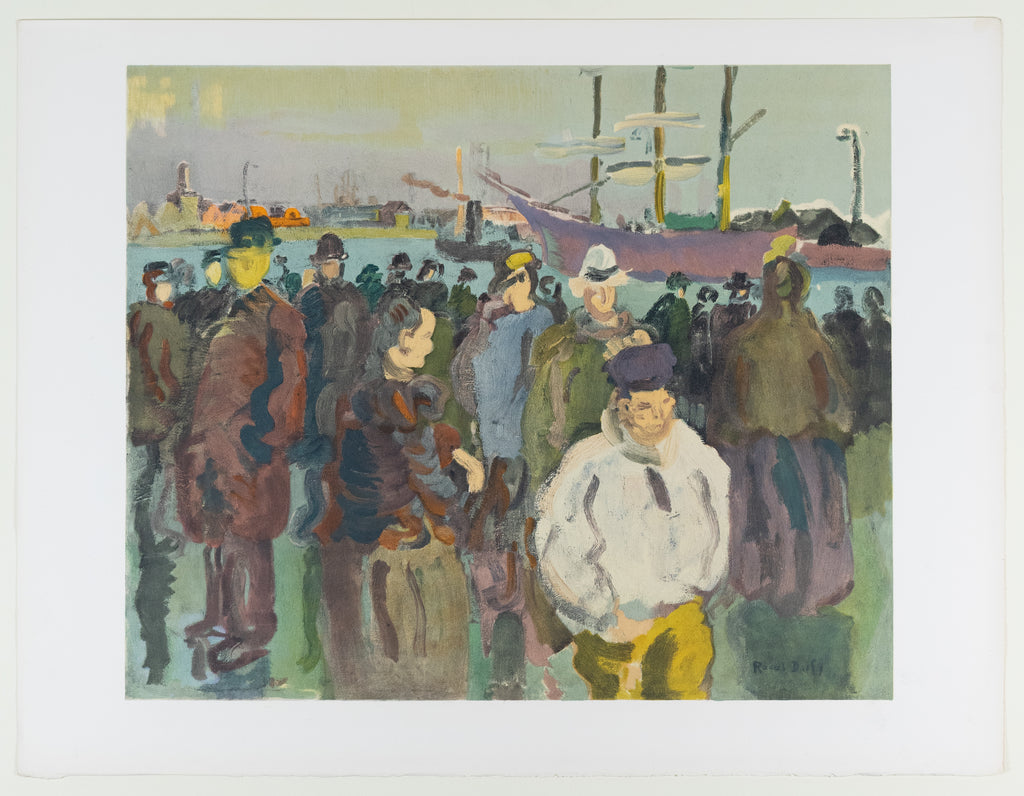Raoul Dufy (1877-1953)(after) - RARE Lithograph
PIERRE LÉVY COLLECTION
NAME: Quai a Rouen
ENGLISH NAME: Quay in Rouen
MEDIUM: Lithography on Arches paper
SIGNATURE: Signed in Plate
SIZE: 20 in x 26 in (50.8 x 66.04 cm)
IMAGE is ACTUAL WORK
Please contact us to request further information or additional images.
QUAY - a concrete, stone, or metal platform lying alongside or projecting into water for loading and unloading ships.
(translated from the Pierre Levy collection)
Quay in Rouen
Raoul Dufy's marked taste for lively streets, squares, markets, manifested itself at the start of his career, particularly in Paris, in 1902, where certain paintings such as La rue Lepic became famous and are placed under the very clear sign of Impressionism, of Pissarro in particular.
From 1905, the probable date of the painting repeated here, we feel the transformation taking place in the artist. The escape is approaching. We see it in the drawing of the characters, accentuated and simplified at the same time: in the attack of the brush, each indication of which takes on the value of a summary; in the distribution of a light no longer coming from above and diffused, but oblique and slamming; in colored masses with delimited contours, having weight and plastic value; in the audacity of a perspective more sentimental than traditional and to which Gauguin and Pont-Aven are no strangers. Raoul Dufy is emerging from his gangue (commercial values material) and Fauvism has already touched him with its passion.
Among the numerous paintings from this period, painted by Dufy in Rouen and from this same observatory with the same buildings in the background, that of the Pierre Lévy collection appears to us to be one of the most important both from the angle of the pleasure that it gives us only under that of the History of Art.
Precursor table. Soon will come - from 1906 - the Rue aux Flags du Havre and Les Affiches performed alongside Marquet, easel against cevalet and which are pure Fauvism.
Note on the character in the background and standing out against the mauve layer of the three masts, the white straw hat surrounded by black which is already a conventional sign. We will see again a thousand times in the paintings to come, these two arcs of a circle, a wider white, a narrow pulsing black. . . summer hats evocative of picnics, country balls, jubilant summer crowds.
Raoul Dufy (1877 - 1953) was french painter and the brother of Jean Dufy. But he was not only a painter, but a draftsman, printmaker, book illustrator, scenic designer, furniture designer and planner of public spaces. Dufy grew up in a large family from Le Havre in Normandy, France. At eighteen years old, he started night classes at the Le Havre École des Beaux-Arts school. There he met Othon Friesz who became his lifelong friend. During this part of his life, he was painting mostly landscapes.
In 1900 he won a scholarship to the École Nationale Supérieure des Beaux-Arts in Paris. He joined up with Friesz again. In addition, he was heavily influenced at the time by Claude Monet and Camille Pissaro. He began exhibiting at Berthe Weill’s gallery and the Salon des Indépendants which started to boost his confidence. It is said that Henri Matisse’s Lux, Calme et Volupté was what caused him to move toward Fauvism. He spend the next 15 years exploring this genre, but in 1920 he was testing Cubism. As he developed his own approach to this style, he created vibrant oils and watercolors with yacht scenes, the French Riviera, parties and musical events.
Dufy is known for his very large painting, the fresco La Fée Electricité for the Paris Expo in 1937. He continued to exhibit in the 1940s and early ‘50s until his hands were struck with rheumatoid arthritis and he struggled to paint. He went to the US for an experimental treatment and it was successful which allowed him to continue with his painting until his death.
Raoul Dufy died in 1953 and is buried near Matisse.



